
Guests
- Natalie Byfieldreporter for the New York Daily News at the time of Central Park Five case. She is now an associate professor of sociology at St. John’s University in Queens. Her new book is called Savage Portrayals: Race, Media and the Central Park Jogger Story.
The City of New York has reportedly agreed to pay $40 million to five men wrongfully convicted of raping a female jogger in Central Park 25 years ago. The five black and Latino men were convicted as teenagers. They initially confessed, but soon they recanted, insisting they had admitted to the crime under the duress of exhaustion and coercion from police officers. Media coverage at the time portrayed them as guilty and used racially coded terms to describe them. But their convictions were vacated in 2002 when the real rapist came forward and confessed, after the five had already served jail terms of up to 13 years. We get reaction to the settlement from Natalie Byfield, a reporter for the New York Daily News at the time of Central Park Five case. Now an associate professor of sociology at St. John’s University in Queens, Byfield is the author of “Savage Portrayals: Race, Media and the Central Park Jogger Story.”
Transcript
JUAN GONZÁLEZ: The City of New York has reportedly reached a $40 million settlement with the five men who were wrongly convicted of raping a female jogger in Central Park 25 years ago. Antron McCray, Kevin Richardson, Raymond Santana, Korey Wise and Yusef Salaam were arrested in 1989 for beating and raping a white woman in New York City’s Central Park. She came to be known as the Central Park jogger. The five boys were all black and Latinos between the ages of 14 and 16. Their arrest made national headlines. They initially confessed, but soon they recanted, insisting they had admitted to the crime under the duress of exhaustion and coercion from police officers.
AMY GOODMAN: In 2002, the convictions in the Central Park Five case were vacated after the real rapist, Matias Reyes, came forward in prison and confessed to the crime. DNA evidence confirmed he was the sole attacker. But by then the five defendants had already served sentences of almost seven to 13 years for the attack.
In 2003, the five men sued sued the city for wrongful conviction and violation of their civil rights. The lawsuit gained renewed attention in 2012, when famed documentary filmmaker Ken Burns and his daughter Sarah released The Central Park Five. This is the trailer from that film.
JIM DWYER: I want us to remember what happened that day and be horrified by ourselves. New York in the late 1980s was a completely schizophrenic, divided city.
REV. AL SHARPTON: New York is now the capital of racial violence.
BERNHARD GOETZ: If I had more bullets, I would have shot them all again and again.
JIM DWYER: Criminality, gang wars, drug wars—we were supposed to be afraid. It would have been irrational not to be afraid.
UNIDENTIFIED: Off with the camera, man!
COMMISSIONER RICHARD CONDON: Last night, a woman jogger was found unconscious and partially clothed in Central Park. She was beaten and sexually assaulted.
ED KOCH: A woman jogging in Central Park. Central Park was holy. It was the crime of the century.
COMMISSIONER RICHARD CONDON: Five youths were arrested on 96th Street, all between 14 and 15 years of age.
ED KOCH: They got ’em!
SAUL KASSIN: You can only imagine the pressure to have this crime solved and solved quickly.
KEVIN RICHARDSON: First we was all together. Then they started to put us in different rooms, separately.
YUSEF SALAAM: “What did you do? Who were you with? Who did you come with?” The tone was very scary. I felt like they might take us to the back of the precinct and kill us.
KOREY WISE: You’re not going to go home until you give up a story.
RAYMOND SANTANA SR.: I told my son, “Go to the park,” that night. I feel guilty.
KEVIN RICHARDSON: I’m telling the guy, “I don’t know what you’re talking about.” They’re getting a little angry.
RAYMOND SANTANA: And they’re like, “You know you did it. Didn’t you?”
UNIDENTIFIED: He had been interrogated for over 24 hours. That amounts to pressure.
NATALIE BYFIELD: These young men were guilty. It was almost unquestioned.
LYNNELL HANCOCK: The police controlled the story. They created the story.
CALVIN O. BUTTS III: They seized on the fears of the people. “Wilding,” the bestial characterization of the black man.
MICHAEL WARREN: There’s no DNA match whatsoever to any of these boys.
RONALD GOLD: I was going nuts. No blood on the kids. Nobody could identify them. But if they confessed, they confessed, and that was that.
JIM DWYER: A lot of people didn’t do their jobs—reporters, police, prosecutors, defense lawyers.
UNIDENTIFIED: This was institutional protectionism.
CRAIG STEVEN WILDER: We falsely convicted them, and we walked away from our crime.
UNIDENTIFIED: This is the ultimate siren that says none of us is safe.
AMY GOODMAN: That was the trailer from the film The Central Park Five. To talk more about the reported new $40 million settlement with the five men, which, by the way, still has to be approved by the city controller and the judge, we’re joined by Natalie Byfield. She was a reporter for the New York Daily News at the time of the Central Park Five case. She’s now an associate professor of sociology at St. John’s University in Queens. And she has a new book out; it’s called Savage Portrayals: Race, Media and the Central Park Jogger Story.
Natalie Byfield, welcome back to Democracy Now! Talk about the significance of what at least is the reported $40 million settlement.
NATALIE BYFIELD: The significance of a settlement, to me, is important because it starts to undo what became a historic lie. And I say it in this way because the case itself was the launching pad for a transformation of the juvenile justice system. So, after the trials were completed, between 1992 and 1999 almost all the states in the country, with the exception of maybe three or four, transformed their juvenile justice laws to incorporate more juveniles into the adult court system. So this case was really quite a launching pad for a very quiet sea change in the juvenile justice system. So the settlement is an institutional acknowledgment that this was a serious mistake, this was a problem, and we have to undo those historic lies so that they don’t get—continue to help to transform the society.
JUAN GONZÁLEZ: Now, Natalie, we were both colleagues at the Daily News at the time of the case—
NATALIE BYFIELD: Yes, yes.
JUAN GONZÁLEZ: —and attended the trial. And you delve in your book into the role of the media in building up the hysteria and the—and amplifying the mistakes that were made by the police department in this case.
NATALIE BYFIELD: Right.
JUAN GONZÁLEZ: And I’m wondering if you could talk about that, because this is really the Scottsboro case of our time, and—
NATALIE BYFIELD: Absolutely.
JUAN GONZÁLEZ: —in terms of what happened here and the role that the media played in inflaming public opinion. If you could talk about that some, too?
NATALIE BYFIELD: The media played a variety of roles, actually, in it. It occurred in the context of the language that was used. And this is the part that was discussed quite a bit. We remember very well terms like “wilding,” terms like “savage,” and this case was in fact the case that was used to invent this concept of wilding. We hadn’t—it hadn’t appeared in our lexicon, certainly not in journalism, before this case. So, this helped to inflame public passions, certainly, the type of language that was used.
In addition to the language that was used, the media just simply failed to interrogate the police. It failed to act as an independent body in the context of the case. So it acted as a mouthpiece for the police department, in essence. So, when the police or the district attorney presented evidence about hairs that matched or were consistent with the hairs of the jogger, and then the evidence sort of appeared and disappeared, there was no interrogation. There were no stories following up on this. When there were reports of a knife being used, and then suddenly the district attorney’s office or the police are not saying anything else about a knife anymore, the things that appeared and disappeared were not interrogated at all.
AMY GOODMAN: And let’s remember, these were 14- to 16-year-old kids.
NATALIE BYFIELD: Absolutely.
AMY GOODMAN: In this excerpt of The Central Park Five documentary, two of the teenagers, Raymond Santana and Kevin Richardson, describe how detectives tried to play them against each other during their separate interrogations.
RAYMOND SANTANA: Hartigan sat down, and he said, “Look, Ray, I know you didn’t do anything wrong, but the other guys right now, they’re in other precincts, and they’re saying that you did it.”
KEVIN RICHARDSON: And they’re telling me, “Well, you’re not saying nothing, but these guys put your name in it.”
RAYMOND SANTANA: And I’m like, “I didn’t do anything.” And he’s like, “Well, this is why I’m here to help you, because I know you didn’t do anything. You’re a good kid. You know, this isn’t you.” He pulls out this picture of Kevin Richardson, and he goes, “You know this kid?” And I’m like, “No, I don’t know him.” And he goes, “You see the scratch under his eye? That came from the woman. We know he did it. He’s going down.”
KEVIN RICHARDSON: At this point, I’m like, you know, like, I don’t know these guys that’s there, so I’m just going to make up something and include these guys’ names.
RAYMOND SANTANA: OK, if—you know, if you’re going to do it to me, then I’m going to do it to you.
AMY GOODMAN: That was Raymond Santana and Kevin Richardson. During the Central Park jogger trial, the defendants were encouraged to consider pleading guilty. This is another clip from The Central Park Five documentary, when Raymond Santana and Yusef Salaam describe the scene.
RAYMOND SANTANA: It got to one point where they pulled me, Yusef and Antron in a conference room. And a lawyer says, “You know, we’re going to lose this case. What we’re planning to do is see if we can get you a plea deal.”
YUSEF SALAAM: And I remember telling them, “You know, you guys can cop out, but if I did something, I would cop out. I would want the least amount of time for what I did. But if I didn’t do anything, you can give me the rest of my life in prison.” You know, I didn’t know what that meant back then, but I just knew that there would be no way that I would cop out to something that I didn’t do.
RAYMOND SANTANA: They said, “Well, it has to be all three of you guys, or it’s nobody.”
AMY GOODMAN: That’s Raymond Santana and Yusef Salaam. Natalie Byfield, as you listen to these men, who now, a quarter of a century later, this case is being settled—Mayor Bloomberg refused to settle.
NATALIE BYFIELD: The failure of the previous administration to settle the case is consistent with their approach to matters like this, matters related to the police. And I really think that it’s important that the new administration, Mayor de Blasio, really stuck to his promise that he would come in and he would settle the case, because we have going on, alongside this case, something that I believe is a direct line from this case: the stop-and-frisk practices. And just in the same way that this case made it OK to criminalize black youth, you see then that black youth, Latino youth, male youth, particularly, become equated with crime, so it made it easier for practices like stop-and-frisk to happen, these types of practices to take place. So, it was very heartening for me to see that Mayor de Blasio challenged the appeal to the stop-and-frisk case and that now we have—we have reached—we have brokered some kind of settlement in that, so to speak, and that we have this other settlement taking place here.
JUAN GONZÁLEZ: And this whole issue you raise of the hand-in-glove relationship between the police department and the media, it’s interesting—we were talking earlier—that one of the key detectives in this case, a guy by the name of Mike Sheehan, who later became one of the big sources for the reporters, ended up leaving the police department and becoming a television reporter.
NATALIE BYFIELD: Yeah.
JUAN GONZÁLEZ: And this whole question of the police department as the main source for much of the information on crime that the media receive?
NATALIE BYFIELD: Well, it’s a really interesting institutional relationship between the police and the press, particularly the newspapers that cover crime and rely on crime stories—and I should say street crime stories—to sort of be part of the fodder of what they regularly report to the public. They need them. We know, working as journalists, that we need them. Part of the practice of working journalists is to work out of police headquarters and develop close relationships with the police. And the problem is when that relationship becomes too close or when you don’t recognize that you’re not part—you’re not part of that team that is policing the world in that way, you don’t belong to that one group. You’re in fact, supposedly, the fourth estate, independent from all these groups, and the overseer, really, and an important element in democracy. So when you forfeit your role to do this, then all sorts of things will happen.
AMY GOODMAN: In 2002, the convicted rapist and murderer, Matias Reyes, confessed in jail that he had committed the rape of the Central Park jogger and he had acted alone. DNA evidence later confirmed his participation in the crime, showed he alone was linked to the semen found in and on the victim. In this excerpt from The Central Park Five documentary, he describes what he did that night.
MATIAS REYES: I showed them the top of the entrance, the direction she came by. I showed them where she made the turn. I showed them where I picked up a tree branch and down the road where I struck her over the head with the tree branch and where I dragged her in. She just kept moaning, you know, saying, “Stop,” and grabbing her head, you know, because she was in pain and all that, you know? She was bleeding. I can’t explain to you what happened after I left there, that park, that night, but I can guarantee you that there was no way these kids saw this woman come in or have a idea of where she was coming from. I’m the one that did this.
AMY GOODMAN: That is the convicted rapist and murderer, who admitted this in jail. He went to—he bumped into one of the Central Park jogger defendants who was in jail and said, “I’m sorry.” And this is how this whole thing unfolded. Now, what’s astounding about the story with Matias Reyes is that he had the MO. He had done this over and over to women; he was a rapist, and he was a murderer. But because the police were blinded by, well, their prejudice around these five young men, he was not investigated. In fact, his case, the reason he went to jail, he raped a woman in my building. And in that case, when he ran out, the doorman jumped him as the woman ran out screaming, and that’s how he ultimately was caught. But so many women would have been saved—
NATALIE BYFIELD: Absolutely.
AMY GOODMAN: —if they had—they never connected the semen to these young men.
NATALIE BYFIELD: No, in fact, there was a rape in Central Park two days before the jogger was raped, and something like 200 yards from the site of the jogger’s attack. So it does seem odd that if you have a pattern of rapes in a particular area, that you don’t examine the possibility that this could have been done by the same person. But they were so wedded to the idea that this group of teens had done it. And it—I have analyzed this to just—to the point where I’ve just concluded that they believed that there was some sort of moral panic going on in our society around the issue of drugs. And we saw the regular nightly news reports, particularly local news reports, across the entire country, where every night they would walk out black and—young black and Latino men and put them—the perp would walk into the car. And—
JUAN GONZÁLEZ: This was at the height of the crack epidemic.
NATALIE BYFIELD: Right, exactly. So, this became—they were the go-to people for all crime. They were—they were equated with crime. So the idea that we have a culture of rape in this country, the idea that there was a problem of rape, didn’t really, for me, really penetrate the investigation in the way it should have, because then they would have investigated other possibilities. But for them, they had latched onto this wilding and this really racialized understanding of what was going on. And I think, in terms of even the newsroom and what got in the way of the investigation were also these racial attitudes and the willingness of the press to buy into these racial attitudes.
JUAN GONZÁLEZ: Well, I want to end with the words of Raymond Santana. He joined us on the show in 2012 and talked about how the case has impacted his life.
RAYMOND SANTANA: I served almost seven years. And so, what happened was that, you know, I tried to get my life back together and put one foot in front of the other, but I didn’t—you know, I didn’t realize the social death that we were given as a sentence. You know, this wasn’t a five to 15 or five to 10; this was a life sentence, a death sentence, in a sense, because, you know, when I came home, I couldn’t get employment. You know, I tried out—filled out numerous applications. And, you know, I had to register as a sex offender. You know, my whole neighborhood looked at me, you know, kind of strange. You know, you get the “Hi, how are you doing?” but, you know, you always have that bullseye on the back, you know, that says, someway, somehow, I’m Raymond Santana from the Central Park jogger case.
AMY GOODMAN: Yes, that was Raymond Santana on Democracy Now! Again, the reported settlement is $40 million, apparently one dollar [sic] a year for each year that these five young men were imprisoned, four of them imprisoned—$1 million a year, four of them imprisoned for seven years and one for 13. The settlement still has to be approved by the city controller and the judge. Natalie Byfield, thanks so much for being with us. She was a reporter for the New York Daily News at the time. She is now an associate professor at St. John’s University. And her new book is called Savage Portrayals: Race, Media and the Central Park Jogger Story.
When we come back, we go to the Capitol Rotunda to speak with a congresswoman who is pushing to stop U.S. forces being committed in Iraq. Stay with us.

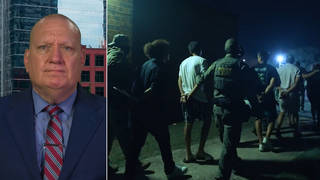

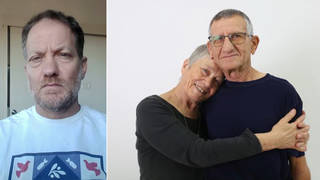
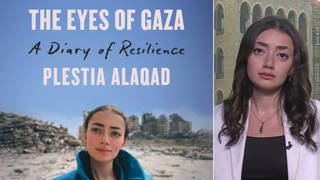



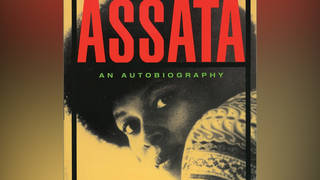

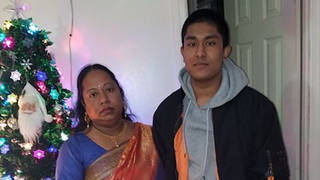
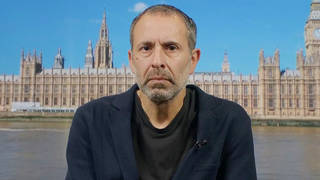
Media Options